In This Issue
The opinions, beliefs and viewpoints expressed in this publication are those of the authors. They do not necessarily reflect the opinions, beliefs, viewpoints or official policies of Autism Society Alberta.
|
|
|
End article-->
Expanding on Intense Interests
Kitty Parlby
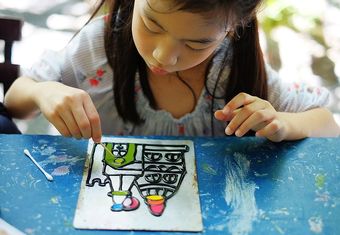 Many of us who have loved ones with autism, or work with autistic individuals, are familiar with intense interests. Sometimes a person can be highly focused and drawn to one or two subjects, whether they be objects, characters, places, technology, animals, numbers or letters, vehicles, or just about anything. Many of us who have loved ones with autism, or work with autistic individuals, are familiar with intense interests. Sometimes a person can be highly focused and drawn to one or two subjects, whether they be objects, characters, places, technology, animals, numbers or letters, vehicles, or just about anything.
In my first decade of immersion in the autism world, I’d often hear this issue referred to with a negative connotation. People would say these ‘obsessions’ distracted the person from being able to learn and socialize effectively. But in the second decade of what might be considered my intense interest, it began to be viewed through an alternate lens – especially once a larger number of autistic adults were able to tell us what these intense passions do for them. In the autistic population, 75% or more have intense interests.
Throughout my years as a one-on-one special-needs E.A., I was always grateful if my student had a passion, as it was a starting point for so many skills that I endeavored to help them improve upon. That included communication, social connection, turn-taking, academic learning, and more. I tapped into their extreme interest to engage their attention, keep them motivated, and make the task or lesson more fun! I also used the same approach at home for my son Eric.
But sometimes, as they progress, a person may need a broader base of subjects to move forward. That’s when I learned how I could facilitate expanding their interests. It is not something to be forced; instead it’s all about exposure to similar, related interests. And sometimes, your excitement about a subject or idea may tempt them to take a closer look.
I hear all the time, from fellow autism parents, that their child (adult or minor) won’t do anything but play computer games, so let’s use this as an example. First of all, it will take considerable time and involvement on your part to sit down with the autistic person and show an interest in what they are playing. Watch them playing, comment on fun things you notice, ask questions about what they like best, and pay attention to what parts of the game get the most reaction from them.
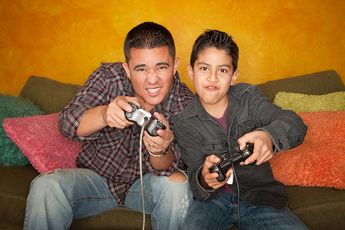 Do they love the part when they get to explore a castle? Then maybe learning more about real castles can be a launching point. Do they love the part when they get to explore a castle? Then maybe learning more about real castles can be a launching point.
Do they get excited when there is action or battles? Then perhaps learning about a variety of fighting and self-defense arts (such as boxing, martial arts, wrestling, fencing, etc.) would be attractive.
Maybe they are fascinated by the clothing, décor, or architecture. These can all lead to various interests.
Do they laugh uproariously at a certain character’s antics? Then perhaps exploring comedy, acting, or drawing their own unique characters would be fun.
Teasing out related interests may require a lot of trial and error, and shouldn’t be rushed or forced. Considering how captivating video games are, it is wise to recognize that this won’t be a quick and easy process.
With some thought and a wide-open imagination, virtually any subject can lead to other interests. Each step taken opens up even more options. Below are a few subjects of intense interest I’ve heard about, with ideas for expansion listed below them.
Trains:
- destinations
- train schedules
- maps
- jobs on trains
- types of engines
- history of trains
- tunnels, canyons, mountains
- streetcars, planes, boats, subways
- trip planning, travel, sightseeing
Princesses:
- clothing design
- castles/architecture
 hairdressing hairdressing- story-writing
- medieval history
- jewelry design
- real princesses, kings, queens
- travel (to other ‘kingdoms’)
- family tree, ancestry
Toilets:
- plumbing parts
- sewer systems
- germs/cleanliness
- outhouses
- history of toilets
- plumbing design
- whirlpools, rapids, waterfalls, waves
- toilets on trains, planes, boats, etc.
- bodily processes/why we need toilets
Letters (Alphabet):
- typing
- reading
- calligraphy
- drawing
- creative writing
- dictionaries
- other written/oral languages
- word searches, crossword puzzles
- activities like email pen pals, spelling bees
Wolves:
- pack dynamics
- canine evolution
- drawing wolves
- wildlife veterinarian
- forest animals
 animal conservation animal conservation- coyotes, foxes, jackals
- dog breeding and training
- indigenous culture and wolves
Finally, having a few more interests could provide benefits for the autistic individual: the relaxation or joy a new interest may bring, increased opportunities to connect with like-minded people, and exposure to possible good-fit job skills. For my son Eric, I wish all these things, and more.
Kitty Parlby is the mother of an autistic young adult. She is a former special needs Educational Assistant and an autism speaker and consultant with Autism Inspirations. She currently works as a Family Resource Coordinator for Autism Society Alberta.
|
|
|
Giving Tuesday
GIVING TUESDAY, on Nov. 30th, is a global generosity movement.
Has Autism Society Alberta uplifted you or your family in some positive way? Perhaps you’ve received one-on-one support from us, joined one of our virtual support group meetings, attended our free virtual informational presentations, or appreciated our advocacy efforts.
Please consider donating to us, so we can continue to be here for you! You can support us HERE: https://autismalberta.ca/online-donation/
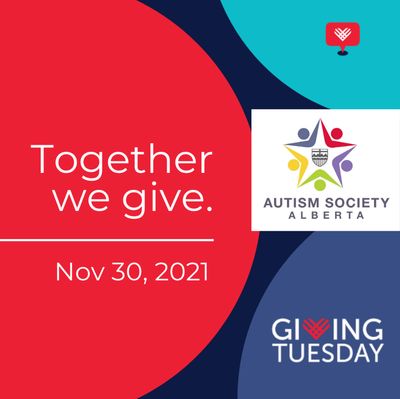
|
|
|
End article-->
Thank You to Gibson Energy
Thank You to Gibson Energy's Giving Week campaign for the generous donation to Autism Society Alberta!
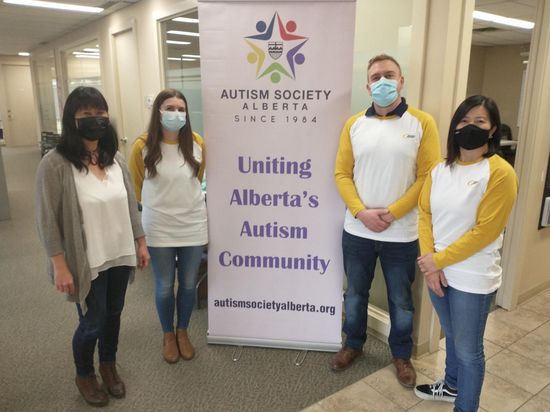
If you or your organization are interested in supporting Autism Society Alberta, please visit https://autismalberta.ca/donate
|
|
|
End article-->
Functions of Behaviour Part 2
Carmen Moore
This month, I will continue to highlight the evidence-based practice of establishing the “function of behaviour”. As I highlighted last month, this is such an important strategy to understand and highlight, as the function of behaviour, or more simply why the person is doing what they are doing, ultimately helps establish a more successful response or strategy. This is a foundational understanding when trying to support anyone, but especially someone with autism. This can be more difficult for non-verbal people, but there are many other ways to communicate the “why” of a certain action.
As we search for a true solution for supporting someone, when looking at the function of behaviour, we need to be careful about how we discuss the situation. For example, if we are describing someone as “lazy”, what we  observe may be that the learner does not complete the task they do. Why might this be the case – what is the true function of behaviour? The work or task may have been too difficult, too easy or under-stimulating, or the performance may not have been consistently reinforced. That is to say, the learner may have needed more verbal praise or visual reminders to keep them motivated and interested. observe may be that the learner does not complete the task they do. Why might this be the case – what is the true function of behaviour? The work or task may have been too difficult, too easy or under-stimulating, or the performance may not have been consistently reinforced. That is to say, the learner may have needed more verbal praise or visual reminders to keep them motivated and interested.
Another example could be that we are describing someone as “violent”, and what we observe may be that the learner is hitting others. Why might this be the case; what could the potential true problem be? The learner may be trying to ‘get suspended’, or taken out of a particular situation they actually find undesirable. The learner may get peer support or admiration for being tough, and feel they are gaining power or respect. A learner may be getting different forms of reinforcement as a result of this behaviour. There could be a sensory issue. I remember my own child, when he was a toddler, would hit me violently when he got hurt. It seemed so unexpected, and this was pre-diagnosis, so I was genuinely confused at his violent outburst. Pain sensitivity played a part, I suspect now.
In another situation, one may describe a learner as “oppositional”, when we observe the learner protesting when directions are given. What may actually be the case is that the task is simply too difficult, the task was not chunked small enough, too many verbal instructions were given, the directions were just not understood, or the learner has discovered that by protesting before the task begins, they are sometimes allowed to avoid the task altogether. I  remember trying this myself as a child when it was time to clean my room: when my mother was tired, I realized she would give into my ‘tantrums’ more easily, and I could avoid cleaning my room at all. Remember, these strategies are good for all, and critical for some. remember trying this myself as a child when it was time to clean my room: when my mother was tired, I realized she would give into my ‘tantrums’ more easily, and I could avoid cleaning my room at all. Remember, these strategies are good for all, and critical for some.
Lastly, I will highlight that we need to recognize and respect the energy levels of the learners (of any age). Behaviour can fluctuate from day to day, or even hour to hour. What was possible one day may not be possible the next, or vice versa. Remember to keep these questions in mind: What am I asking of him/her? What has he/she already done? How taxing has the day been so far? How taxing is the event or task coming up? Does he/she need a break? What are their current behaviours trying to communicate to me? For example, what one can accomplish after a great nights’ sleep and hearty breakfast, may differ from what one is able to do after a long day of work or when feeling cold, hot, hungry, tired, etc.
When you are trying to determine the true function of a learner’s behaviour, it is important to follow a few key steps:
-
Establish a team: Oftentimes we become desensitized to a situation when we have been in it for a long time. It is difficult to have a full/true perspective when you are trying to approach it alone. Getting outside eyes, including other trained ‘experts’ (if available), like a psychologist, occupational therapist, speech pathologist, nutritionist, behavioural expert, classroom teacher or EA, or parent, is essential. There are different observations that can be made and shared through different ‘lenses’. Be open to other perspectives.
-
Identify and define the behaviour: Clearly pinpoint what exactly you wish to see and hear from the learner, especially if they are trying to acquire a new skill. For example, if you simply say, “I want him/her to be less lazy”, then you will be less likely to achieve that or even know when the learner truly experiences success. You may want to make the goal that the learner will stick to a chosen task – for example folding the  laundry and putting it away – without leaving the work area or getting distracted. It should also be completed in a reasonable amount of time (e.g. 15 minutes). That is much easier to support and know once success has been achieved. laundry and putting it away – without leaving the work area or getting distracted. It should also be completed in a reasonable amount of time (e.g. 15 minutes). That is much easier to support and know once success has been achieved.
-
Data Collection: Choose a form of data collection, so that the learner and the data collector can track the level of success the learner is having. It can be a chart with the start and finish times listed, to see if the learner gets closer to the actual goal time set. This can be formal or informal data collection tool(s), but if they are chosen at the outset, it makes the tracking more manageable. It is nice for the learner, if possible, to track, record, and celebrate their own growth and success!
This wraps up my ‘function of behaviour’ series. If you are interested in further information, I highly recommend the free online AFIRM modules.
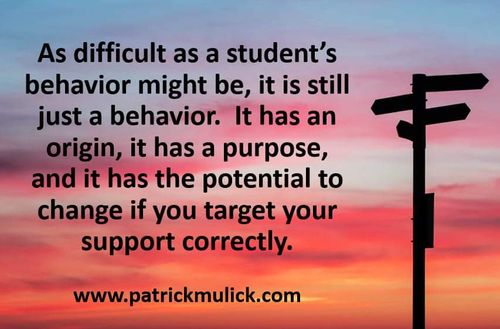
|
|
|
Bags in the Wind
Carina Moran
 Noah: “Hey Mom, have you ever seen a grocery bag blow around on a windy day? Have you ever run so hard to catch it, but no matter how fast you go, you can never quite grab it…?” Noah: “Hey Mom, have you ever seen a grocery bag blow around on a windy day? Have you ever run so hard to catch it, but no matter how fast you go, you can never quite grab it…?”
“Yes, buddy. Why do you ask?”
“Because that’s how I feel with friends, mom. I try to chase after them. But no matter how hard I try, they always run away from me.”
I don’t know if I have ever heard a more eloquent description. Friendships. Relationships. Life in and of itself. These are all indeed delicate things – delicate as a bag blowing in the wind. In order to expand, grow and move, we all require life to be breathed into us.
When you’re on the spectrum, sometimes bags blow around you so fast, you don’t know what to make of them. At first, you don’t even see them - because you are caught up in your own moment of experiencing the wind. You relish the sensation as it rushes past your ears, and you savour the excitement as it dances around your body and creates a cacophony of sound – sound that only you can hear. When you stop for a moment to look past the wind, you finally notice the bags blowing. You’re curious. You want to go touch them. But by the time you make a move towards them, they are already far out of your reach. You decide to run after them, but no matter how fast your legs can go, you just can’t keep up. So eventually, you stop running. And you settle for simply enjoying the bags from afar, as only you know how to do.
The thing is, chasing after anything in life is futile. We cannot control the wind. It has a mind of its own and will blow in many different directions. Eventually, whether we realize it or not, a bag – your bag, the one you were always meant to have – will find its way to you. Stop running. Stop chasing. Instead, go outside and simply enjoy the wind. Raise your arms at your sides. Let it blow through you. Let it propel you. Feel it as it rolls past your fingertips and envelops you with its swirling embrace. Listen to it. Hear every note. On every invisible tendril, it carries a song.
 Close your eyes and immerse yourself in it. And when you do eventually open your eyes again, you might be surprised at the things that it blew in your direction. Things that you didn’t have to chase. All you have to do is simply open your hands and receive them. Close your eyes and immerse yourself in it. And when you do eventually open your eyes again, you might be surprised at the things that it blew in your direction. Things that you didn’t have to chase. All you have to do is simply open your hands and receive them.
Harnessing the power of the wind. Kids on the spectrum know how to do it. If only we took the time to do it too. How different our lives would be: lighter, more carefree… like a bag blowing in the wind.
|
|
|
When the Good Ones Go
Hope Rudics
 Well, we received the dreaded message in two parts, from our most cherished and beloved respite worker (who we will call Ethan, because that is his name, and who is an outstanding human being). The first part was: “We need to talk.” Well, we received the dreaded message in two parts, from our most cherished and beloved respite worker (who we will call Ethan, because that is his name, and who is an outstanding human being). The first part was: “We need to talk.”
I thought that sentence was only stressful in personal relationships. I have come to learn that I was absolutely wrong. A million and one things ran through our heads while we waited for that day’s pick-up to happen. Did our son do something the week prior? Was there an incident? Our son hadn’t even left for respite that day. What on earth would we need to talk about that couldn’t be done via telephone or text messages, like the other 99.9% of our interactions?
Then, upon his arrival, he continues: “I’m moving back.” We knew it was coming. Ethan was only in our city to attend school to become a teacher, a profession that couldn’t have been a better match for him. But unfortunately for us, because he moved here for school and has now completed it, he will be moving back home, a few hours away, to pursue the next chapter of his life.
Like I said, we knew this was coming, and I will admit we tried to pretend that it wasn’t going to happen. But in the back of our minds, we knew how great Ethan was, and have always been so excited for someone like him to join the world of teaching. A teacher like him is and will be rare. The optimist in me says that the good news is that the agency we are with, which gave us Ethan, never disappoints. I know they will find us another amazing match. But change can sometimes be hard and uncomfortable, and to be honest, I might be having a harder time with it than my son at the moment. Maybe it’s because I see how great they are together. Maybe it is because my son hasn’t fully processed what the end result of Ethan moving away will be. Most likely both.
Many tears were shed, from everyone. I might even have two or three running down my cheek as I write this. A good respite worker isn’t always 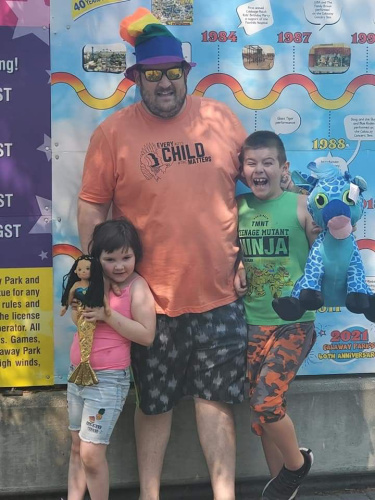 easy to find, and once you find them, it’s not guaranteed that you get to keep them forever. So when the good ones go, we have to stay positive and remember that although they are sometimes hard to find, there are spectacular people out there just waiting to be matched with our special little humans. All we can do now is wait to see what new friendship will develop, and help our little one navigate through whatever emotions these next few weeks may bring. easy to find, and once you find them, it’s not guaranteed that you get to keep them forever. So when the good ones go, we have to stay positive and remember that although they are sometimes hard to find, there are spectacular people out there just waiting to be matched with our special little humans. All we can do now is wait to see what new friendship will develop, and help our little one navigate through whatever emotions these next few weeks may bring.
As always, thank you for reading, and don’t forget to be kind, be brave and do good, recklessly.
|
|
|
Magic Moments
Karla Power
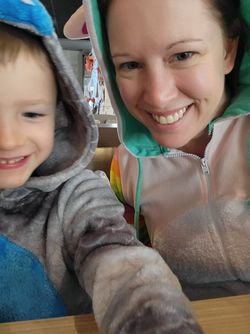 A wise friend of mine recently said to me, “Not every day is going to be good, but you can find good in every day.” Even though life has been quite challenging lately, she has a point. If I really think about it, good moments can be found, even on our toughest days. A wise friend of mine recently said to me, “Not every day is going to be good, but you can find good in every day.” Even though life has been quite challenging lately, she has a point. If I really think about it, good moments can be found, even on our toughest days.
And then there are moments that seem to make all the behaviours, regressions, and challenges disappear for a while. I call these “magic moments”. These are the moments that make you smile from ear to ear, and wish you had gotten it on camera, if you weren’t quick enough to do it. They are the moments that make you so proud, you want to share them with the world! These moments create connections and hope.
Recently, our family has been fortunate enough to experience some magic moments, courtesy of the boys. As a mom of two children on the spectrum, I tend to have some goals for the boys that are similar, and others that are very different. Kelton, our youngest, is fairly social, but Paddy can be quite aloof. One of our biggest goals for him in Grade 1 this year is that he will make meaningful connections with his peers. It has always been more important to me that Paddy gets along with people his age, rather than spend his whole school day interacting with adults.
Luckily, Paddy’s EA recognized that these connections were important as well, and she began sharing some special connections that he was making with his peers in his communication book. This allowed us to start having conversations with Paddy about his new friends. I was able to capture one particular conversation that I had with Paddy about a new friend on video, and it was absolutely amazing to see his expression change and his face light up when I mentioned her name.
I am also pretty pleased that Kelton, my youngest son, has really started to show affection to people he cares about. Kelton has a great capacity for empathy (he tends to get upset when characters in the show he is watching get hurt or feel sad), and just this fall, he learned how to kiss, conveniently right before we took our family photos. I will forever cherish the picture we got of mother and son sharing a kiss.
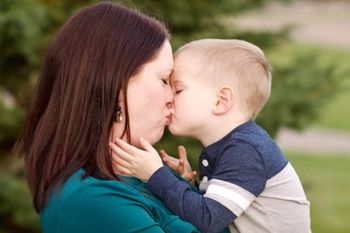 These magic moments are just two examples of things I wasn’t sure would be possible. To have a meaningful conversation with my oldest son, who is non-verbal, and have him show me that he understands, was an amazing experience. Having my youngest son be able to show me how much he really loves me, without words, was something this mama will never forget. These magic moments are just two examples of things I wasn’t sure would be possible. To have a meaningful conversation with my oldest son, who is non-verbal, and have him show me that he understands, was an amazing experience. Having my youngest son be able to show me how much he really loves me, without words, was something this mama will never forget.
I know that the boys are capable of great things, and I look forward to seeing what other magic moments we will experience in this life.
|
|
|
Informative Article on Masturbation and ASD
While an uncomfortable topic for many, families in our community have found this article by Maureen Bennie of the Autism Awareness Centre to be most helpful. The article provides links to several publications and professional resources. You can read it by clicking here.
|
|
|
End article-->
Centre for Autism Services Alberta – Programs for Teens and Adults

The Centre for Autism Services Alberta is a non-profit organization that serves individuals with autism and their families. Our programs range from early diagnosis and services starting as young as 18 months, all the way to our young adult and adult programs.
Much of the time, focus lands on programs for preschool and school-age children. However, in this article, we would like to highlight some of our programming available for older youth, young adults, and adults.
EmploymentWorks National Project (EW)

The EmploymentWorks program is available to individuals 15 years and older with a disability. The EW program provides the next step of workplace training and mentorship to youth and adults who are out of school and interested in entering the job market.
 Our EW program offers employment preparedness training and job sampling work experience for individuals who have been diagnosed with a disability, including, but not limited to, autism. This peer/co-worker supported program is designed for individuals seeking opportunities to develop the skills necessary to obtain meaningful and sustainable paid employment. What better way to learn the fundamentals of a position than to learn from someone who already does it! This built-in support helps individuals enrolled in the program to focus on social, communication, and job skills development, and lets them test the waters in a variety of workplace settings and teams. EmploymentWorks uses adult learning principles to reach participants where they are and helps them acquire a set of skills to enter meaningful employment. Our EW program offers employment preparedness training and job sampling work experience for individuals who have been diagnosed with a disability, including, but not limited to, autism. This peer/co-worker supported program is designed for individuals seeking opportunities to develop the skills necessary to obtain meaningful and sustainable paid employment. What better way to learn the fundamentals of a position than to learn from someone who already does it! This built-in support helps individuals enrolled in the program to focus on social, communication, and job skills development, and lets them test the waters in a variety of workplace settings and teams. EmploymentWorks uses adult learning principles to reach participants where they are and helps them acquire a set of skills to enter meaningful employment.
The program is 6 months in length, and is split into two sections. Months 1-3 offer structured learning combined with on-site work experience. Months 4-6 transitions participants from weekly programming into active job seeking and embarking on employment.
The next cohort for EmploymentWorks begin their journey in January 2022! We are also offering a virtual option for this program if individuals are more comfortable learning from a distance. For more information, visit our website at centreforautism.ab.ca/program/employmentworks/
Quest for Independence Program
 Quest is an innovative post-secondary program that helps build skills of independence for living and integrating into the community. Participants in the Quest program work and learn together in person, either at the model apartment at the Centre for Autism Services Alberta or at the Quest apartments in Old Strathcona. Questers learn how to prepare meals, keep house, manage money and social engagements, develop vocational skills through volunteering, and explore their communities through social, leisure, and recreational activities. Quest is an innovative post-secondary program that helps build skills of independence for living and integrating into the community. Participants in the Quest program work and learn together in person, either at the model apartment at the Centre for Autism Services Alberta or at the Quest apartments in Old Strathcona. Questers learn how to prepare meals, keep house, manage money and social engagements, develop vocational skills through volunteering, and explore their communities through social, leisure, and recreational activities.
In addition to making social connections with fellow-Questers, young adults and their families can expect to see increases in:
- community inclusion
- self-determination
- self-advocacy
- skills of independence
- and an increased level of engagement in recreation and leisure activities and opportunities
For more information on our Quest for Independence program, visit our website at centreforautism.ab.ca/program/quest-for-independence/
Whether you are a youth seeking to enter the workforce for the first time, or a family considering ways to increase your ASD young adult’s independence, we have several programs at the Centre that can provide wonderful support. It is our goal at the Centre to help individuals of all ages with Autism Spectrum Disorder lead meaningful, engaged lives.
|
|
|
End article-->
Upcoming Events from Autism Edmonton

Silent Santa is Back!
This event, presented by Londonderry Mall in partnership with Autism Edmonton, offers a sensory-friendly experience for children to meet and have their photos taken with Santa. This year, Silent Santa appointments are available on November 28th, December 5th and December 12th from 9:00 a.m. to 11:00 a.m. Guests can book in increments of 5-10 minutes. For more details click here.

Autism Edmonton's IDPD Celebration on December 3
On December 3, 2021, Autism Edmonton will be hosting a series of online presentations to celebrate the International Day of persons with Disabilities (IDPD). Learn more here: http://www.autismedmonton.org/idpd-celebration.

Autism Edmonton Presents: Glow Without Limits!
Glow Festival and Autism Edmonton are teaming up again to offer a special event for our members that aims to accommodate guests with sensory sensitivities. Glow Without Limits will take place on December 17, 1-3 PM, before the festival opens to the public. To make the event more affordable, autistic children under 18 get in for FREE! Check out the details by clicking here.

New Initiative: Coffee & Chat
 Autism Edmonton is excited to announce that one of our members stepped up to initiate a peer-hosted group for autistic adults called "Coffee and Chat," and our staff are excited to assist him with this autistic-led initiative. The first meeting is scheduled for November 30, 2:00 pm-4:00 pm. It will be a hybrid event with the opportunity to join via Zoom OR in-person at the Autism Edmonton office. You’ll find more information here: http://www.autismedmonton.org/new-initiative-coffee-chat Autism Edmonton is excited to announce that one of our members stepped up to initiate a peer-hosted group for autistic adults called "Coffee and Chat," and our staff are excited to assist him with this autistic-led initiative. The first meeting is scheduled for November 30, 2:00 pm-4:00 pm. It will be a hybrid event with the opportunity to join via Zoom OR in-person at the Autism Edmonton office. You’ll find more information here: http://www.autismedmonton.org/new-initiative-coffee-chat
|
|
|
End article--> |
|